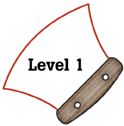
Alaska Science
Key Element A10
A student who meets the content standard should understand that living things are made up mostly of cells and that all life processes occur in cells (Cells).
 |
Alaska Science A student who meets the content standard should understand that living things are made up mostly of cells and that all life processes occur in cells (Cells). |
|
Performance Standard Level 1, Ages 5–7
|
|
|
|
Sample Assessment Ideas
|
Standards Cross-References
|
||
|
National Science Education Standards Each plant or animal has different structures that serve different functions in growth, survival, and reproduction. For example, humans have distinct body structures for walking, holding, seeing, and talking. (Page 129) Tools help scientists make better observations, measurements, and equipment for investigations. They help scientists see, measure, and do things that they could not otherwise see, measure, and do. (Page 138) |
Benchmarks Magnifiers help people see things they could not see without them. (Page 111) Most living things need water, food, and air. (Page 111) |
|
Table of Contents | Return to Alaska Native Knowledge Network